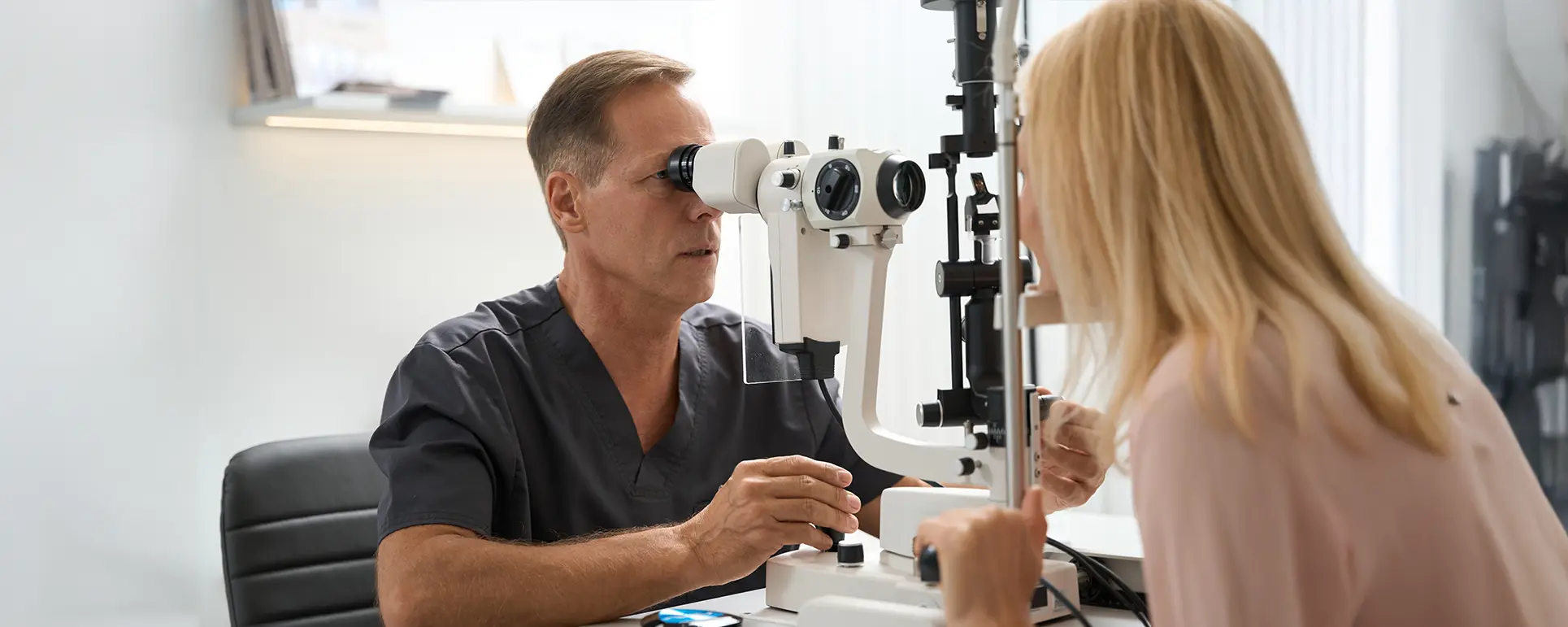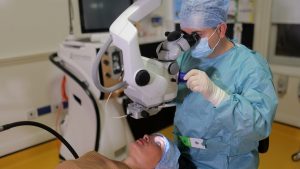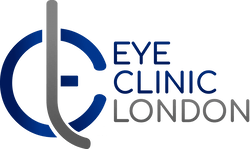Which Is Better LASIK or LASEK? Key Differences Explained

If you’re thinking about laser vision correction, chances are you’ve heard about LASIK and LASEK. Both procedures aim to correct common vision problems like nearsightedness, farsightedness, and astigmatism, helping you reduce your dependence on glasses or contact lenses.
But here’s the thing: even though they share the same goal, LASIK and LASEK are quite different in how they work, how your eyes recover, and the risks and long-term results you can expect. Knowing these differences is key so you can choose the procedure that best fits your eyes, lifestyle, and comfort level.
In this guide, I’ll walk you through everything you need to know from how each procedure is performed to what recovery looks like, potential side effects, and which one might give you the results you’re hoping for. By the end, you’ll have a clear idea of which option could be the right fit for you, making the decision much easier and less stressful.
Understanding LASIK

What Is LASIK?
If you’re curious about LASIK, here’s the lowdown. LASIK, which stands for Laser-Assisted In Situ Keratomileusis, is a procedure that reshapes your cornea to improve your vision. It’s designed to reduce or even eliminate your need for glasses or contact lenses. During the procedure:
- A thin flap is created in your cornea using either a precise laser or a small surgical blade called a microkeratome.
- The flap is carefully lifted to expose the underlying corneal tissue.
- An excimer laser then reshapes your cornea to correct your vision accurately, targeting nearsightedness, farsightedness, or astigmatism.
- Finally, the flap is repositioned, allowing it to heal naturally without stitches.
This approach is quick, precise, and designed to minimise disruption to your daily life.
Advantages of LASIK
You might wonder why LASIK is so popular. Here’s why many people choose it:
- Rapid visual recovery: Most patients notice improved vision within 24–48 hours, so you could be reading or driving almost immediately after your procedure.
- Minimal discomfort: Eye drops that numb your eyes make the procedure virtually painless. Some patients feel a little pressure or mild irritation, but it’s usually brief.
- High predictability: LASIK works especially well if you have mild to moderate vision issues, giving consistent and reliable results.
- Long-lasting effects: For many people, the correction remains stable for years, letting you enjoy clear vision without constant touch-ups.
Considerations and Risks
While LASIK is generally safe, it’s important to know what could happen and whether it’s the right fit for you:
- Flap-related complications: Rarely, the corneal flap can shift, wrinkle, or heal imperfectly, which might affect your vision.
- Dry eyes: Temporary dryness or irritation is common after LASIK. Most patients notice it improves within a few weeks.
- Not suitable for thin corneas: If your cornea isn’t thick enough, LASIK may not be the safest option for you. Your surgeon will check this before recommending the procedure.
By understanding what LASIK involves and what to expect, you can better decide if it’s the procedure that fits your lifestyle and vision goals.
Understanding LASEK

What Is LASEK?
If you’re exploring laser vision correction, you’ve probably noticed LASEK mentioned alongside LASIK. LASEK, or Laser-Assisted Subepithelial Keratectomy, works in a similar way to LASIK but takes a gentler approach to your cornea. Here’s what happens during the procedure:
- A thin layer of your corneal epithelium (the outermost layer of your cornea) is loosened using a mild alcohol solution.
- This layer is carefully lifted, giving the surgeon access to the underlying corneal tissue.
- An excimer laser reshapes the cornea to correct your vision.
- The epithelial layer is then replaced, acting as a natural bandage that protects your eye as it heals.
Because LASEK doesn’t involve creating a deep flap, it can be a safer option if your corneas are thinner or if you’re at a higher risk of flap-related complications.
Advantages of LASEK
You might find LASEK appealing for several reasons:
- Safer for thin corneas: Since there’s no deep flap, patients with thinner corneas can often safely undergo LASEK.
- Reduced flap risks: You won’t face the same potential flap complications that can occur with LASIK.
- Effective for higher prescriptions: In some cases, LASEK can correct stronger levels of nearsightedness that LASIK might not be able to treat as safely.
Considerations and Risks
While LASEK is a great option for certain patients, there are a few things to keep in mind:
- Longer recovery time: Unlike LASIK, your vision may take 3–7 days to stabilise fully, so you might need a bit more patience before seeing clearly.
- Initial discomfort: Some people feel mild pain, burning, or irritation as the epithelial layer heals.
- Temporary haze or light sensitivity: You might notice your vision is slightly hazy or sensitive to bright light at first, but this usually improves within a few weeks.
By understanding how LASEK works and what to expect, you can weigh the benefits and challenges against your lifestyle and vision needs.
Key Differences Between LASIK and LASEK
If you’re trying to decide between LASIK and LASEK, here’s what you should know. With LASIK, a thin flap is created in your cornea, whereas LASEK only lifts the outer epithelial layer without cutting deeply. This difference affects recovery: most people notice their vision improving within 1–2 days after LASIK, while LASEK can take 3–7 days to stabilise.
You’ll also feel less discomfort with LASIK usually minimal while LASEK may cause mild irritation or a burning sensation as your eye heals. LASIK carries a small risk of flap-related complications, but that’s not an issue with LASEK.
When it comes to who can get each procedure, LASIK is best suited for people with normal corneal thickness, while LASEK is often recommended if you have thin corneas or if LASIK isn’t safe for you. Both options provide long-term stability, but if you play contact sports or lead a very active lifestyle, LASIK may let you get back to your routine a little faster, whereas LASEK might require extra care in the first few days.
By keeping these differences in mind, you can choose the procedure that fits your eyes, comfort level, and lifestyle best.
Who Should Consider LASIK?
You might find LASIK to be a great option if your eyes and lifestyle match certain criteria. For example, it’s ideal if you have adequate corneal thickness, which allows the surgeon to safely create the flap needed for the procedure. You’ll also benefit if you’re looking for rapid visual recovery many people notice a significant improvement in their vision within just 24–48 hours, so you could be back to driving, reading, or working almost immediately.
If minimal discomfort is important to you, LASIK can be a comfortable experience. The use of anaesthetic drops usually keeps pain to a minimum, and most patients report only mild pressure during the procedure itself.
LASIK is also suitable if your lifestyle involves low-risk activities where there’s little chance of trauma to the eye, since flap-related complications, though rare, are a consideration. You might especially appreciate LASIK if you want a solution that fits seamlessly into your busy life it’s quick, predictable, and generally requires minimal downtime.
Ultimately, LASIK can offer you a convenient, effective, and long-lasting way to reduce or even eliminate your need for glasses or contact lenses. If you’re hoping for clear vision with minimal interruption to your daily routine, LASIK could be the procedure that gives you the results you’re looking for.
Who Should Consider LASEK?
You might find LASEK to be the better choice if your eyes or lifestyle make LASIK less suitable. For instance, if you have thin or irregular corneas, LASEK is often safer because it doesn’t require a deep corneal flap.
If you play contact sports or participate in high-impact activities, LASEK can also be a good fit since there’s no flap that could be displaced, reducing potential complications. Similarly, if you’re at higher risk for flap-related issues or have had eye surgeries in the past, LASEK offers a safer approach.
LASEK can also be recommended if you have stronger prescriptions that require careful corneal reshaping, allowing for precise correction without compromising your long-term vision.
While the recovery period is longer than LASIK, the procedure provides a reliable and long-lasting outcome, making it a solid option if safety and corneal integrity are your top priorities. If you’re willing to be patient during the healing process, LASEK can help you achieve clear, stable vision safely.
Recovery Expectations
LASIK Recovery
If you decide to go with LASIK, one of the biggest advantages is the speed of recovery. Many people notice significant improvement in their vision within 24–48 hours, so you could be reading, working, or even driving almost immediately after your procedure.
During the first few days, it’s normal to experience mild dryness, glare, or light sensitivity, especially in bright sunlight or while using screens. These side effects typically fade within a few weeks as your eyes adjust and heal. Many patients notice improvement within a few days, though the exact timing varies depending on individual healing and type of work. Just be mindful of activities that could accidentally impact your eyes, like swimming or dusty environments, during the first week.
LASEK Recovery
Recovery after LASEK is a bit slower, and your eyes require a little more patience. Vision usually stabilises over 3–7 days, meaning you may notice fluctuations or blurriness before your eyesight fully clears.
Because the outer layer of your cornea the epithelium needs to heal, you might experience more initial discomfort than with LASIK. This can include mild burning, irritation, or a scratchy feeling, especially during the first couple of days. To support healing and protect your eyes, your surgeon may place temporary protective contact lenses. These act like a bandage and usually stay in place for several days while the epithelium regenerates.
Vision usually stabilises over several days, and recovery time can vary from person to person. Most patients are able to resume work and daily activities once they feel comfortable. Bright lights, prolonged screen use, or strenuous activity may need to be limited initially. While LASEK requires a bit more patience during recovery, it offers a safe and reliable outcome, especially if LASIK isn’t suitable for you.
By knowing what to expect from each procedure, you can plan your schedule, manage your comfort, and set realistic expectations for your healing process. This helps ensure a smoother, less stressful recovery, no matter which option you choose.
Risks and Complications
Even though both LASIK and LASEK are generally very safe, it’s important that you understand the potential risks so you can make an informed decision.
One possibility is overcorrection or undercorrection your vision may end up slightly over- or under-adjusted. If that happens, you might need an additional enhancement procedure to fine-tune your eyesight.
Dry eyes are another common side effect, especially in the first few weeks after surgery. Most cases are temporary and can be managed with lubricating eye drops or small lifestyle adjustments, like taking screen breaks and staying hydrated.
Some people also notice night vision issues, such as glare, halos, or starbursts around lights. These usually improve as your eyes heal, but it’s something to keep in mind if you drive frequently at night.
For LASIK specifically, there’s a small risk of flap complications, like dislodging or wrinkling of the corneal flap. While this is rare, it’s something to consider if you lead a physically active lifestyle or play contact sports.
Ultimately, choosing the procedure that suits your eyes and lifestyle can reduce the likelihood of complications and give you the best chance of achieving clear, stable vision. Discussing your options with a qualified surgeon will help ensure that the procedure is tailored to your needs and safety.
Making the Choice: LASIK or LASEK?
Deciding between LASIK and LASEK comes down to your eyes, lifestyle, and personal preferences.
If you have thin or delicate corneas, LASEK is often the safer choice because it doesn’t require creating a deep corneal flap. On the other hand, if you’re looking for quick visual recovery and minimal downtime, LASIK may fit better with your routine, letting you get back to work or daily activities in just a couple of days.
Your level of activity also matters. If you play contact sports or engage in high-impact activities, LASEK can be safer initially since there’s no flap that could be affected, whereas LASIK is generally fine for lower-risk activities.
The strength of your prescription can influence the choice as well. LASEK may be preferred if you have a higher prescription requiring precise corneal reshaping, while LASIK works best for mild to moderate vision corrections.
Finally, think about your comfort with recovery time. LASIK is faster and often more convenient, but LASEK, while slower to heal, avoids flap-related risks and is a reliable option for certain patients.
The best way to make an informed decision is to consult an eye specialist. They can assess your corneal thickness, eye health, lifestyle, and vision goals to recommend the procedure that’s safest and most effective for you. With the right guidance, you can feel confident in your choice and look forward to clearer vision.
Role of a LASIK Specialist
A qualified eye clinic in London can:
- Evaluate corneal thickness, curvature, and prescription suitability.
- Discuss personal preferences for recovery speed and comfort.
- Recommend LASIK or LASEK based on evidence and experience.
- Provide professional aftercare to ensure optimal long-term vision.
FAQs About LASIK and LASEK:
- How do I know if I’m a candidate for LASIK or LASEK?
To determine if you’re a good candidate, you’ll need a detailed eye examination that evaluates your corneal thickness, prescription strength, and overall eye health. LASIK tends to work best if your corneas are thick enough and your vision issues are mild to moderate, while LASEK is usually safer if your corneas are thinner, irregular, or if your prescription is higher. Your surgeon will guide you in choosing the procedure that suits your eyes safely. - Does the procedure hurt?
Both LASIK and LASEK are generally painless because numbing eye drops are used throughout the procedure. With LASIK, you may feel mild pressure when the corneal flap is created, but any discomfort is brief. LASEK may cause more noticeable irritation or a burning sensation while the epithelial layer heals, particularly during the first few days, but this is temporary. - How quickly will I see improvements in my vision?
If you choose LASIK, you’ll likely notice a significant improvement in your vision within 24 to 48 hours, allowing you to resume most daily activities quickly. LASEK requires a slower recovery, and your vision may take three to seven days to fully stabilise. Even after this period, it’s normal for your eyes to fluctuate slightly as they continue to heal. - What are the main risks I should be aware of?
While both procedures are considered very safe, there are some potential side effects. You could experience overcorrection or undercorrection, which might require a follow-up enhancement procedure. Dry eyes are common, though usually temporary, and some people notice glare or halos around lights, particularly at night. LASIK has a small risk of flap-related complications, which is important to consider if you are physically active, but LASEK avoids this issue altogether. - Can I return to work or daily activities quickly?
Most patients who undergo LASIK are able to return to work within one to three days, depending on the type of work and how comfortable they feel. With LASEK, it generally takes about a week before your vision and comfort level are suitable for work and other daily activities. In both cases, it’s wise to avoid situations where your eyes could be exposed to injury, such as swimming or contact sports, during the initial recovery period. - Are results permanent?
Both LASIK and LASEK provide long-lasting vision correction, and many patients enjoy years of improved eyesight without needing glasses or contact lenses. However, it’s worth remembering that natural changes in your eyes due to aging can still occur, and some individuals may require touch-ups years later, especially if their initial prescription was high. - What’s the difference in lifestyle suitability?
LASIK is convenient if you want fast results and minimal downtime, making it easier to fit into a busy routine. LASEK can be a better choice if you play contact sports or engage in high-impact activities, as there’s no flap to worry about. Both procedures offer the potential to significantly reduce your reliance on glasses or contact lenses, but your lifestyle and activity level may influence which option is best. - Will I experience dry eyes after surgery?
It’s normal to feel some dryness at first, but this usually settles after a few weeks. You can use lubricating drops and take breaks from screens or other activities that strain your eyes. Staying hydrated and following your surgeon’s instructions can help your eyes feel more comfortable as they heal. - How do I decide which procedure is right for me?
Choosing the right procedure comes down to your corneal thickness, prescription strength, lifestyle, and how comfortable you are with the recovery period. LASIK offers faster healing and less immediate discomfort, whereas LASEK avoids flap complications and is safer for thinner or more delicate corneas. A consultation with a qualified eye specialist will assess your eyes and guide you toward the safest and most effective option for your situation. - What kind of aftercare is required?
After either procedure, following your surgeon’s instructions is essential. You’ll likely have follow-up appointments to monitor healing, use prescribed eye drops, and take precautions to protect your eyes from injury or infection. Activities such as swimming, rubbing your eyes, or intense physical exertion may need to be avoided for a short period, and taking care of your eyes during this time ensures optimal results and a smoother recovery.
Final Thoughts: Choosing Between LASIK and LASEK
Deciding between LASIK and LASEK comes down to your eyes, your lifestyle, and how you feel about the recovery process. Both procedures are safe and effective ways to reduce or eliminate your dependence on glasses or contact lenses. LASIK offers faster visual recovery and minimal initial discomfort, while LASEK is often safer for thinner corneas or those at risk of flap-related complications, making it ideal for more active lifestyles or higher prescriptions.
During recovery, it’s important to follow your surgeon’s instructions, protect your eyes, and attend all follow-up appointments. Understanding the differences between the procedures and setting realistic expectations can help ensure a smoother healing process and long-lasting clear vision. If you’re considering Lasek surgery in London, you can reach out to us at Eye Clinic London to discuss your options and book a consultation.
References:
- Kuryan, J., Cheema, A., & Chuck, R. S., 2017. Laser-assisted subepithelial keratectomy (LASEK) versus laser-assisted in-situ keratomileusis (LASIK) for correcting myopia. Cochrane Database of Systematic Reviews, (2), Art. No.: CD011080. Available at: https://www.cochranelibrary.com/cdsr/doi/10.1002/14651858.CD011080.pub2/full
- AlArfaj, K. & Hantera, M. M., 2014. Comparison of LASEK, mechanical microkeratome LASIK and femtosecond LASIK in low and moderate myopia. Saudi Journal of Ophthalmology, 28(3), pp. 214–219. Available at: https://www.sciencedirect.com/science/article/pii/S1319453413001082
- Lee, J. H., Snyder, R. W., Schwiegerling, J. & Miller, J., 2002. LASEK vs. LASIK visual outcomes. Investigative Ophthalmology & Visual Science, 43(13), p. 4137. Available at: https://iovs.arvojournals.org/article.aspx?articleid=2421381
- Walland, M. J., Pesudovs, K., Coster, D. J. & Williams, K. A., 2007. LASEK versus LASIK for the correction of moderate myopia. Optometry and Vision Science, 84(7), pp. 577–582. Available at: https://journals.lww.com/optvissci/Abstract/2007/07000/LASEK_Versus_LASIK_for_the_Correction_of_Moderate.17.aspx
- Park, S. H., Kim, J. Y., Lee, S. M. & Tchah, H., 2020. Comparison between surgical outcomes of LASIK with and without laser asymmetric keratectomy to avoid conventional laser refractive surgery adverse effects. Scientific Reports, 10(1), Article 10364. doi:10.1038/s41598-020-67269-y. Available at: https://www.nature.com/articles/s41598-020-67269-y

